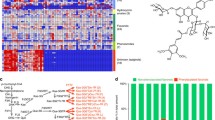Summary
Two macromutants [unbranched (Ub) and restricted branched (Rb)], one point mutation [yellow flowerd (‘Ada’)] and two flowering variants (early and late) were isolated in the M2 generation of gammairradiated progenies of black henbane (H. niger) — a medicinal plant belonging to family Solanaceae. These major gene changes were coupled with simultaneous changes in several polygenic systems conditioning continuous variation for flowering time, plant height, numbers of shoots and leaves, biomass and crude drug content. Such quantitative variation in qualitative mutants were measured for both per se means and cross-bred performance in terms of: (1) shifts in univariate means, (2) changes in pooled divergence, (3) alterations in gca effects, and (4) changes in heterotic capacity. The mutants were significantly divergent from the parental base for all the six metric traits, both individually as well as collectively. Divergence among mutants was wider (D2 = 1491 to 11 469) than that for mutants versus source parent (D2 = 117 to 7120). Conspicuous alterations in both the nature and the magnitude of the gca effects associated with all mutants, except L-2013 (late flowering), relative to the parental base were observed for all of the metric traits examined (gca ∼- per se means). Similarly, the mutants manifested greater heterotic potential than the parental base. This is even more strongly reflected in mutant x mutant hybrids for all of the characters. The amount of economic heterosis for diverse traits followed the pattern: crude drug > biomass > flowering time ∼- plant height > number of shoots ∼- number of leaves.
Similar content being viewed by others
References
Anonymous (1982) Markets for selected medicinal plants and their derivatives. International Trade Centre, UNCTAD/ GATT, Switzerland, p 104
Anonymous (1987) Annual report, 1986–87. CIMAP, Lucknow, pp 70–71
Anonymous (1988) Annual report, 1987–88. CIMAP, Lucknow, pp 66–67
Bianchini F, Corbetta F, Pistoia M (1977) Health plants of the world (atlas of medicinal plants). Newsweek Books, New York
Cromwell BT (1955) The alkaloids. In: Peach K, Tracey MV (eds) Modern methods of plant analysis, vol 4. Springer-Verlag, Berlin, p 499
Gaul H (1965) The concept of macro- and micro-mutations and results on induced micro-mutations in barley. In: The use of induced mutations in plant breeding (Report FAO/IAEA Technical Meeting, Rome, 1964). Pergamon Press, Oxford, pp 408–426
Giriraj K, Hiremath SR, Seetharam (1990) Induced variability for flowering, seed weight and oil content in parental lines of sunflower hybrid BSH-1. Indian J Genet 50:1–8
Griffing B (1956) Concept of general and specific combining ability in relation to diallel crossing systems. Aust J Biol Sci 9:463–493
Konotop LI (1968) Heterosis obtained by crossing mutant sublines of corn. In: Induced mutations in cross breeding. (Panel Proc Series.) IAEA, Vienna, p 86.
Micke A, Donini B, Maluszynski M (1987) Induced mutations for crop improvement — a review. Trop Agric 64: 259–278
Morgun V, Shkvarnikov PK, Chuchmyl I, Boreiko V (1973) In: Induced mutations in cross breeding. (Panel Proc Series.) IAEA, Vienna, p 187
Morton JF (1977) Major medicinal plants. Charles C. Thomas, Illinois, USA, pp 303–305
Rao CR (1952) Advanced statistical methods in biometrical research. John Willey & Sons, New York
Rawat RS, Tyagi DV (1989) Mutant heterosis in pearl-millet. Indian J Genet 49:19–24
Romer FW, Micke A (1974) Combining ability and heterosis of radiation-induced mutants of Melilotus albus. In: Polyploidy and induced mutations in plant breeding. (Panel Proc Series.) IAEA, Vienna, p 275
Scossiroli RE (1970) Mutations in characters with continuous variation. In: Technical Report Series No. 119. IAEA, Vienna, pp 117–123
Sharma JR, Singh OP (1983) A promising induced mutant in black henbane (Hyoscyamus niger L.). Curr Sci 52:988–989
Sharma JR, Lal RK, Lavania UC, Gupta MM, Mishra HO (1986) Productivity and cytogenetic analysis of an unbranched mutant in Hyoscyamus niger L. Plant Breed 97:375–378
Sharma JR, Lal RK, Mishra HO, Gupta MM, Ram RS (1989) Potential of gamma radiation for enhancing the biosynthesis of tropane alkaloids in black henbane. Euphytica 40:253–258
Sinha RP, Joshi MG (1986) Variability in triticale following hybridization and mutagenesis. Indian J Genet 46:472–475
Sinhamahapatra SP (1986) Induced changes in the background genotype in relation to the mutated locus in jute. Indian J Genet 46:496–500
Sinhamahapatra SP, Rakshit SC (1981) Effect of selection for plant height in X-ray-treated populations of jute (C. capsularis L.). Z Pflanzenzuecht 86:329–336
Stoilov M, Daskaloff S (1976) Some results on the combined use of induced mutations and heterosis breeding. In: Induced mutations in cross breeding. (Panel Proc Series.) IAEA, Vienna, pp 179–188
Author information
Authors and Affiliations
Additional information
Communicated by R. Hagemann
Rights and permissions
About this article
Cite this article
Sharma, J.R., Lal, R.K., Mishra, H.O. et al. Induced polygenic changes occurring simultaneously with major gene changes in black henbane (Hyoscyamus niger L.). Theoret. Appl. Genetics 85, 445–450 (1992). https://doi.org/10.1007/BF00222326
Accepted:
Issue Date:
DOI: https://doi.org/10.1007/BF00222326




